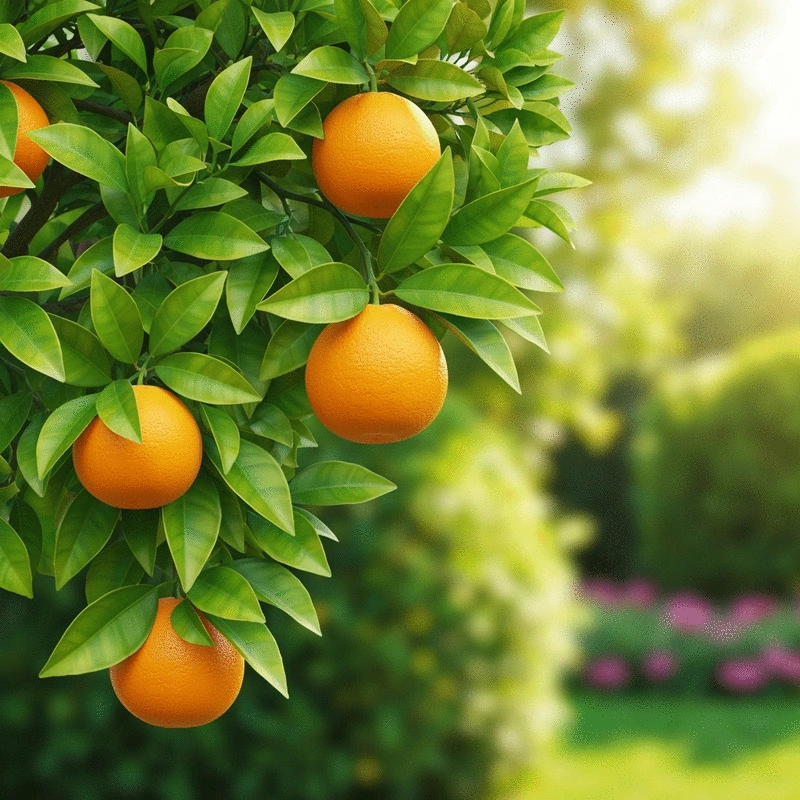Caring for Orange Trees Seasonally

What if a little seasonal care could transform your orange trees from ordinary to extraordinary? Understanding the unique needs of your trees throughout the year is key to unlocking their full potential. Let's explore the vital insights that will elevate your gardening journey!
What You Will Learn
- Different seasons present unique challenges; tailored care can significantly boost tree health.
- Consistent watering, especially in hot months, is crucial for avoiding stress on your trees.
- Regular pruning enhances air circulation and sunlight penetration, promoting better growth.
- Monitoring nutrient levels and adjusting fertilizer based on seasonal needs is essential for fruitful trees.
- Being proactive about pest and disease management is key to maintaining tree vitality.
Orange Tree Seasonal Care Overview
A visual guide explaining the crucial seasonal care practices for maintaining healthy and productive orange trees throughout the year.
Spring: New Growth & Blooming
- ✓ Focus on new growth
- ✓ Fertilization to boost nutrients
Summer: Watering & Pest Control
- ✓ Adequate watering (heat stress)
- ✓ Monitor for pests
Autumn: Winter Preparation
- ✓ Pruning
- ✓ Ensure disease-free
Winter: Frost Protection & Reduced Watering
- ✓ Protect from frost
- ✓ Limit watering (growth slows)
Understanding Seasonal Care for Orange Tree Health
Seasonal care is vital for the health of your orange trees! Just like us, these trees need different types of attention as the seasons change. By understanding how to care for your trees throughout the year, you can ensure they thrive and produce delicious fruit. At Orange Insights, we want to share our expertise, helping you cultivate not just trees, but rewarding gardening experiences.
Many factors affect orange trees during each season, from temperature fluctuations to rainfall patterns. Implementing appropriate seasonal care can make a significant difference in the overall health and productivity of your trees. Let’s dive deeper into why this care is crucial for growing oranges in your backyard!
Why Seasonal Care is Crucial for Orange Trees
Maintaining your orange trees through seasonal changes is essential for several reasons:
- Health Maintenance: Different seasons come with unique challenges, like pests or diseases, which can affect your trees.
- Fruit Production: Proper care ensures that your trees are robust enough to produce quality fruit when the time comes.
- Stress Reduction: Seasonal care helps minimize stress on your trees, making them more resilient against environmental factors.
By focusing on seasonal care, you align your gardening practices with the natural rhythms of your orange trees, paving the way for a fruitful harvest. Remember, a little attention during each season can lead to a big payoff!
Common Questions About Orange Tree Seasonal Care
I often receive questions about seasonal care for orange trees, and here are a few common ones:
- What are the key tasks for each season?
- How do I know when to fertilize?
- What signs should I look for that indicate my tree needs more care?
These questions reflect the concerns of many orange tree enthusiasts. Addressing them can help you feel more confident in your care routine and enhance your gardening journey!
Impact of Seasonal Weather Patterns on Orange Tree Care
Weather patterns greatly influence how we care for our orange trees. In Australia, we experience distinct seasons, each requiring tailored care strategies:
- Spring: Focus on new growth and blooming. Fertilization can boost nutrient levels.
- Summer: Ensure adequate watering to combat heat stress and monitor for pests.
- Autumn: Prepare your trees for winter; this includes pruning and ensuring they're disease-free.
- Winter: Protect your trees from frost and limit watering as growth slows.
Understanding these seasonal weather patterns will help you make informed decisions about your care techniques, ensuring your orange trees remain healthy and productive year-round! For more details on common issues, check out pests that affect orange trees.
Interactive Poll: Your Seasonal Care Experience
We want to hear from you! What is the most challenging aspect of caring for your orange trees throughout the seasons? Share your thoughts below:
Wrapping Up Your Seasonal Care Journey
As we wrap up our journey on seasonal care for orange trees, it's essential to reflect on the key aspects that contribute to their health and vitality. Taking a proactive approach not only ensures a bountiful harvest but also nurtures your connection with these vibrant trees. Let's explore some key takeaways to remember as you continue to care for your orange trees!
Key Takeaways for Maintaining Orange Tree Health
- Consistent watering is crucial, particularly during hot months.
- Regular pruning encourages better air circulation and sunlight penetration.
- Keep an eye on the nutrient levels and adjust fertilizer applications based on seasonal needs.
- Monitor for pests and diseases regularly to catch issues early.
By focusing on these fundamental aspects, you can significantly enhance the overall health of your orange trees. Remember, consistent care is the key to a flourishing garden! It's a rewarding journey filled with learning and growth, both for you and your trees.
Encouraging Healthy Growth: Your Next Steps in Orange Tree Care
Now that you have a solid understanding of seasonal care, it's time to take actionable steps toward encouraging healthy growth in your orange trees. Consider the following strategies:
- Create a seasonal care calendar to track watering, pruning, and fertilization schedules.
- Utilize organic fertilizers to boost nutrient levels naturally.
- Engage with local gardening communities or forums to share experiences and gain insights.
- Stay informed about seasonal weather patterns that may affect your trees.
These steps not only help in maintaining the trees but also enrich your gardening experience! By remaining engaged and informed, you’ll foster a vibrant and productive garden.
Monitoring Tree Health and Recognizing Signs of Stress
Lastly, understanding how to monitor your trees and recognize signs of stress is vital for long-term success. Here are some indicators to look out for:
- Yellowing leaves may signify nutrient deficiencies or overwatering.
- Wilting or drooping branches can indicate insufficient water or root issues.
- Stunted growth may suggest a lack of sunlight or nutrient uptake problems.
- Presence of pests or unusual spots on leaves should prompt immediate investigation.
By being proactive in monitoring and addressing these signs, you can keep your orange trees thriving. Remember, observing details is part of the joy of gardening! With your dedication, I'm confident your orange trees will flourish beautifully throughout the seasons.
Recap of Key Points
Here is a quick recap of the important points discussed in the article:
- Seasonal care is essential for maintaining the health and productivity of orange trees.
- Different seasons require specific tasks, such as fertilization in spring and frost protection in winter.
- Regular monitoring for pests, diseases, and signs of stress ensures early intervention and tree vitality.
- Creating a seasonal care calendar can help you stay organized and consistent with your gardening practices.
Frequently Asked Questions About Orange Tree Seasonal Care
Q: Why is seasonal care important for orange trees?
A: Seasonal care is crucial because orange trees have different needs throughout the year, influenced by temperature, rainfall, and growth cycles. Tailored care prevents stress, promotes health, and ensures abundant fruit production.
Q: What are the main tasks for orange trees in spring?
A: In spring, the focus is on new growth and blooming. Key tasks include fertilization to boost nutrient levels and ensuring adequate water for emerging blossoms.
Q: How should I care for my orange trees during summer?
A: During summer, adequate watering is essential to combat heat stress. It's also important to monitor regularly for pests, which can be more active in warmer months.
Q: What should I do to prepare my orange trees for winter?
A: In autumn, prepare your trees for winter by pruning them to remove dead or weak branches and ensuring they are disease-free. In winter, protect them from frost and significantly limit watering as their growth slows.
Q: What are common signs of stress in orange trees?
A: Common signs of stress include yellowing leaves (nutrient deficiencies or overwatering), wilting or drooping branches (insufficient water or root issues), stunted growth (lack of sunlight or nutrient problems), and the presence of pests or unusual spots on leaves.
Popular Posts
 What if a little seasonal care could transform your orange trees from ordinary to extraordinary? Und
What if a little seasonal care could transform your orange trees from ordinary to extraordinary? Und
 Reducing waste in orange production is more than just a trend; it's a commitment towards sustainabil
Reducing waste in orange production is more than just a trend; it's a commitment towards sustainabil
 Have you ever considered how a simple fruit like an orange can elevate your summer desserts? With th
Have you ever considered how a simple fruit like an orange can elevate your summer desserts? With th
 Are you ready to make a difference with every bite you take? Embracing organic oranges not only tant
Are you ready to make a difference with every bite you take? Embracing organic oranges not only tant
